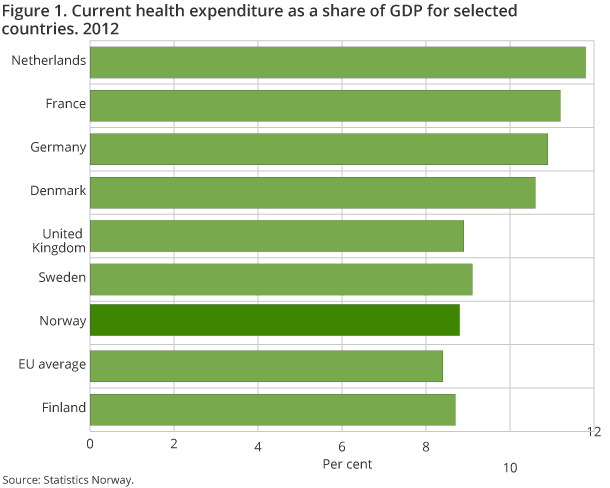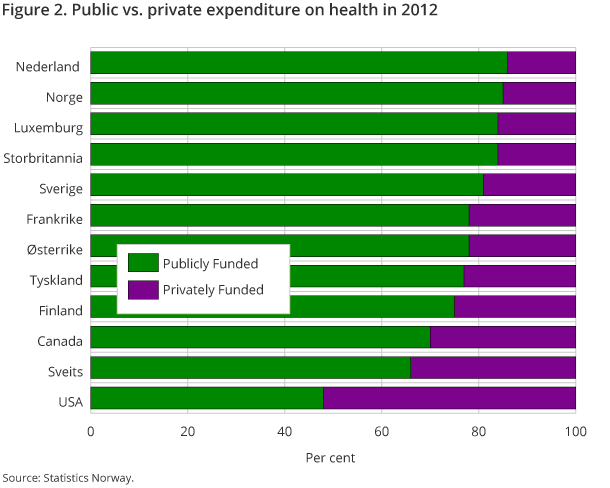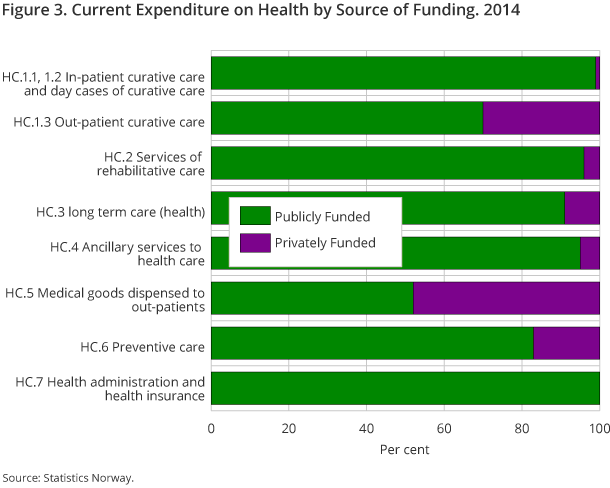Content
Published:
This is an archived release.
Health expenditures grow with the population
Preliminary estimates show that current health expenditures amounted to NOK 290 billion in 2014. The volume increased by 1.3 per cent from the year before. The increase is of a similar magnitude to the population growth, and health expenditures per capita, adjusted for price changes, are therefore quite similar to the previous year.
| 2011 | 2012 | 2013 | 2014 | |
|---|---|---|---|---|
| 1Figures for the last two years are preliminary. | ||||
| 2Current health expenditure does not include capital formation | ||||
| Current expenditure on health | 245 441 | 260 182 | 274 078 | 289 991 |
| Volume growth from previous year | 2.7 | 0.9 | 1.3 | |
| Capital formation in health care institutions. NOK million | 12 584 | 14 458 | 17 634 | 20 053 |
| Current expenditure on health. Per cent of GDP | 8.8 | 8.8 | 8.9 | 9.2 |
| Current expenditure on health. Per cent of GDP Mainland Norway | 11.4 | 11.3 | 11.3 | 11.5 |
| Current health expenditure per capita | 49 553 | 51 844 | 53 951 | 56 447 |



Figures from the health accounts show that current health expenditures amounted to NOK 56 400 per capita in 2014, which corresponds to a volume growth of 0.1 per cent from 2013. This means that when adjusted for price and wage inflation, the health expenditures per capita remained almost unchanged from the year before.
Current health expenditure amounts to 9.2 per cent of GDP
Health expenditure as a share of GDP is often used in international comparisons of health expenditures. Preliminary estimates show that current health expenditures amounted to 9.2 per cent of GDP in 2014. In 2012, the share was 8.8 per cent. This is somewhat higher than the EU average, which was 8.4 per cent in 2012 - the latest figure available from the OECD. Of the EU countries, the Netherlands spent the most on health, followed by France, with a spend of 11.8 and 11.2 per cent of the GDP respectively. For the Nordic countries, the proportion ranged from 8.7 to 11.8 per cent. It is worth mentioning that for some countries, including Sweden, new guidelines are expected to increase health expenditures.
When looking at GDP shares, Norway’s health expenditure might seem low compared to the other countries mentioned above. However, it is important to remember that Norway has a high GDP per capita. In the annual publication Health at a Glance, the OECD converts the health expenditure to a common currency, and adjusts for differences in purchasing power. According to these figures, Norway and Switzerland have the highest health spending per capita in Europe.
GDP can fluctuate due to price changes and variations in oil and gas production. It is therefore often more relevant to use GDP Mainland Norway when comparing GDP shares over time. Current expenditure as a share of GDP Mainland Norway has remained stable at around 11.3 to 11.5 per cent over the last four years.
Public health expenditure of NOK 247 billion
The share of public financing varies over time and between countries. In recent years, the share of public financing in Norway has remained stable at around 85 per cent. This means that the public spent approximately NOK 247 billion on health in 2014. By comparison, total public spending was NOK 1418 billion, which means that health spending accounted for over 17 per cent of the public's total expenses.
The public financing share of 85 per cent is well above average for the EU countries, which was 73 per cent in 2012. Generally, the Nordic countries have a high proportion of public funding. Norway and Denmark have the highest proportion, both with 85 per cent. Of the Nordic countries, Finland has the lowest proportion, with 75 per cent of health spending financed by the public.
The proportion of expenditures financed by the public sector also varies between types of healthcare services. For some services, households largely pay for themselves, while the public mainly pays for other types of services. Dental services have the highest proportion of private funding. In-patient curative care, on the other hand, is almost completely publicly funded. Long-term care and rehabilitation are also mainly publicly funded. For both of these types of services, the share of public financing is in excess of 90 per cent.
Gross capital formation NOK 20 billion in 2014
The preliminary estimates for 2014 show that the gross capital formation amounted to about NOK 20 billion. This is a historically high level and is partly related to the construction of a new hospital in Østfold.
Of the NOK 20 billion, about NOK 3.5 billion was research and development investment. This mainly includes salaries and other input costs related to the research and development conducted at the hospitals. R&D represents a value in the form of knowledge that can be beneficial in the coming years.
New revised guidelines from the OECD
This year, the health accounts follow revised guidelines from the OECD System of Health Accounts (2011). Due to this, there are some changes in the classification of health care functions, providers and financing, compared to previous years’ publications. In addition, the guidelines clarify which parts of long-term care should be included in the health accounts. This ensures comparability between countries. For Norway, the new guidelines do not change the magnitude of health spending significantly. From 2016, it will be mandatory for all EU/EEA countries to follow the new guidelines.
In addition to the aforementioned changes, the OECD discourages the use of the term total health expenditure. The aim is instead to use the terms current expenditure on health and gross capital formation separately. The reason is that current expenditure refers to final consumption, whereas gross capital formation refers to health providers’ demand for capital. These components should not be summed, as they represent different timing of health consumption. In 2014, the current health spending amounted to NOK 290 billion, while investments in health purposes were about NOK 20 billion.
Revision of the national accountsOpen and readClose
In addition to new guidelines for the health accounts, figures in the National accounts have been revised. The Health accounts are based on figures from the National accounts, and will therefore be affected by this. Read more about the revision of the national accounts.
Volume growth in national figures differs from OECD estimateOpen and readClose
The volume growth in our national figures may differ from the growth estimated by the OECD in the publication “Health at a Glance”. This is because the OECD uses a method where the total health spending figures are deflated using an economy-wide GDP deflator. In the Norwegian figures, the volume growth is calculated according to the national accounts method, meaning that many different but relevant price indices are used or that the volume changes are observed directly. An example of the latter is the hospitals’ DRG system, which can have information on the volume of hospital services.
Contact
-
Eirik Larsen Lindstrøm
E-mail: eirik.lindstrom@ssb.no
tel.: (+47) 46 78 22 92
